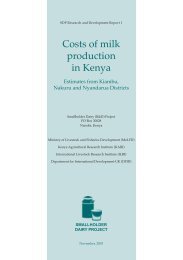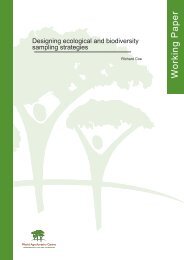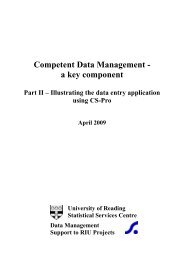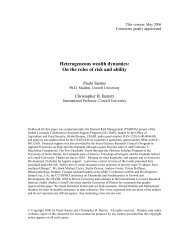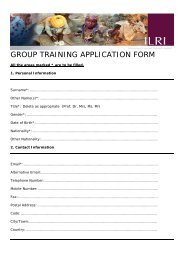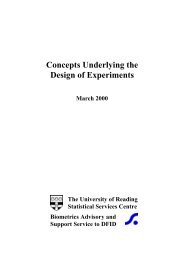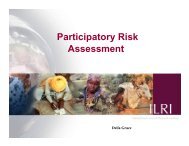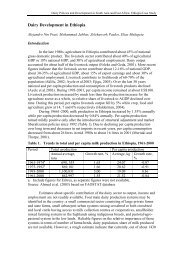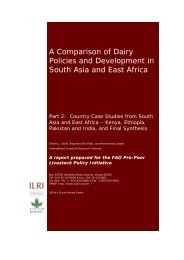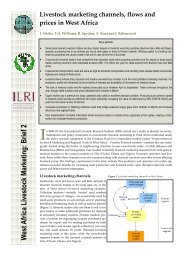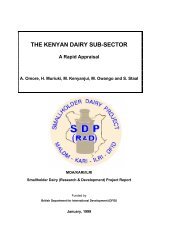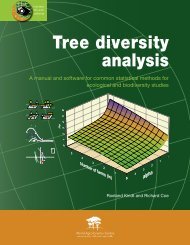agr<strong>of</strong>orestry systems that <strong>in</strong>clude multipurpose trees, such as alley-farm<strong>in</strong>g and the three-strata forage systemdescribed for Bali, Indonesia by Nitis et al (1990).There is considerable potential for improved land use and <strong>in</strong>creased <strong>in</strong>come through pastureimprovement <strong>in</strong> the perennial tree crop systems (Shelton and Stur 1991; Copland et al 1994). Examples <strong>of</strong>rum<strong>in</strong>ant–plantation crop comb<strong>in</strong>ations <strong>in</strong>clude cattle under coconut, oil palm and mango; sheep undercoconut, rubber, oil palm and durian; and goats under coconut. There is also considerable potential for<strong>in</strong>clud<strong>in</strong>g rum<strong>in</strong>ants <strong>in</strong> forestry plantations. In the past, most attention has been given to the <strong>in</strong>tegration <strong>of</strong>cattle with coconut, especially the tall traditional palm varieties. In coconut the light penetration is relativelyconstant and bright throughout the life <strong>of</strong> the crop, which benefits the herbage understorey. Non-productiveweed species <strong>in</strong> plantations can be replaced with productive improved species. In rubber and oil palmespecially, legum<strong>in</strong>ous cover crops have been planted to control less-desirable weed species and contributeto the early growth <strong>of</strong> the trees through nitrogen accretion. However, it is imperative that the <strong>in</strong>troduction <strong>of</strong>forages and graz<strong>in</strong>g animals <strong>in</strong>to plantations does not <strong>in</strong>terfere substantially with the management <strong>of</strong> the treesand reduce their yields. Legumes are less competitive than grasses, although there is variation between grassspecies <strong>in</strong> their competitive behaviour. Application <strong>of</strong> <strong>in</strong>organic fertilisers can reduce competition, whilst thegraz<strong>in</strong>g animals produce manure and promote the recycl<strong>in</strong>g <strong>of</strong> nutrients to improve tree yields.ManureBoth rum<strong>in</strong>ants and non-rum<strong>in</strong>ants provide manure for the ma<strong>in</strong>tenance and improvement <strong>of</strong> soil fertility.Manure is used widely throughout the ASEAN sub-region, the Mekong countries and South Ch<strong>in</strong>a. Wherethe use <strong>of</strong> artificial fertilisers is low, soil fertility depletion is a major constra<strong>in</strong>t to agriculture, particularly<strong>in</strong> the humid and sub-humid climates. Even when <strong>in</strong>organic fertilisers are applied, crop yields may not bema<strong>in</strong>ta<strong>in</strong>ed under cont<strong>in</strong>uous cultivation on nutrient-poor sandy soils with a low buffer<strong>in</strong>g capacity. The use<strong>of</strong> only m<strong>in</strong>eral fertilisers can decrease soil pH and base-saturation and <strong>in</strong>crease alum<strong>in</strong>ium toxicity. Organicmaterials applied <strong>in</strong> bulk can improve soil texture, promote better absorption <strong>of</strong> moisture, reduce run-<strong>of</strong>f andprevent crust<strong>in</strong>g <strong>of</strong> the soil surface. Even small quantities <strong>of</strong> organic materials can br<strong>in</strong>g about markedimprovements <strong>in</strong> the cation exchange capacity <strong>of</strong> soils. Manure is also valuable <strong>in</strong> revers<strong>in</strong>g the deterioration<strong>in</strong> soil structure <strong>in</strong> sodic soils, characterised by high contents <strong>of</strong> exchangeable sodium and low permeability.In <strong>in</strong>tegrated crop–pig–aquaculture systems <strong>in</strong> South-East Asia, pig manure is dra<strong>in</strong>ed and the cleareffluent applied as fertiliser to vegetable plots or to rice fields. The solid component is used for the production<strong>of</strong> biogas. In Vietnam, manure from <strong>in</strong>tensive peri-urban pig and poultry production systems around Ho ChiM<strong>in</strong>h City is applied to fish ponds. In irrigated rice–duck–aquaculture systems, duck excreta fertilises therice crop and also provides food for the fish. In perennial plantation crop systems, animals graz<strong>in</strong>g theunderstorey vegetation provide manure to <strong>in</strong>crease tree yields.Benefits <strong>of</strong> crop–animal <strong>in</strong>teractionsThe crop–animal <strong>in</strong>teractions referred to <strong>in</strong> the previous section benefit small farmers and contribute to thesusta<strong>in</strong>ability <strong>of</strong> mixed farm<strong>in</strong>g systems. Draft animals can speed up operations such as plough<strong>in</strong>g andcultivat<strong>in</strong>g, and <strong>in</strong>crease the land area prepared for cropp<strong>in</strong>g. Improved tillage requires extra power for whichresources <strong>of</strong> hand labour are presently <strong>in</strong>adequate, whilst soil conservation operations such as terrac<strong>in</strong>g andridg<strong>in</strong>g are unlikely to be undertaken with hand cultivation. <strong>Animal</strong>s can provide the required extra power.The lower compaction result<strong>in</strong>g from land preparation us<strong>in</strong>g animal traction, compared to tractor plough<strong>in</strong>g,also reduces the erosion hazard. In South-East Asia, hillsides have been levelled <strong>in</strong>to terraces for rice fields,and then re-levelled us<strong>in</strong>g draft animal power annually to ensure even spread <strong>of</strong> water and its re-distributionto the lower paddies. Without such a system, erosion <strong>of</strong> rice fields would have made farm<strong>in</strong>g unsusta<strong>in</strong>ablewith<strong>in</strong> a few years. The vast majority <strong>of</strong> farmers <strong>in</strong> the region do not have the resources to replace draft animalpower with tractors. The environmental benefits and economic sav<strong>in</strong>gs to Asian nations through the use <strong>of</strong>draft animal power has been highlighted by Ramaswamy (1985), who estimated that it would take 30 milliontractors to replace some 300 million draft animals on small farms. The use <strong>of</strong> renewable animal power <strong>in</strong>stead
<strong>of</strong> non-renewable fossil fuels and tractors has, amongst other th<strong>in</strong>gs, reduced carbon dioxide and carbonmonoxide emissions <strong>in</strong>to the atmosphere.In Thailand, manure has susta<strong>in</strong>ed yields <strong>of</strong> rice at 1.5–2.0 t/ha for centuries, with the m<strong>in</strong>imal use <strong>of</strong>artificial fertilisers (de Guzman and Petheram 1993). In Java, Indonesia, farmers collect feed refusals <strong>in</strong> pitsbeneath their animal barns. The refusals comb<strong>in</strong>e with faeces and ur<strong>in</strong>e fall<strong>in</strong>g through slatted floors toproduce compost. This is ranked by farmers as one <strong>of</strong> the most important outputs from animal production.In the uplands <strong>of</strong> Java, 90% <strong>of</strong> the fertiliser used <strong>in</strong> smallhold<strong>in</strong>gs is compost and is essential to thesusta<strong>in</strong>ability <strong>of</strong> some <strong>of</strong> the most <strong>in</strong>tensive cropp<strong>in</strong>g cycles <strong>in</strong> the world (Tanner et al 1995).Probably most buffaloes, a large proportion <strong>of</strong> beef and draft cattle, and small numbers <strong>of</strong> goats andsheep <strong>in</strong> the region are dependant on cereal straws for ma<strong>in</strong>tenance at some time dur<strong>in</strong>g the year. Rice strawis <strong>of</strong>ten fed dur<strong>in</strong>g the crop-grow<strong>in</strong>g season, when animals have little or no access to graz<strong>in</strong>g, and dur<strong>in</strong>g thedry season when other feeds are <strong>in</strong> short supply or exhausted. In the dry season, levels <strong>of</strong> crude prote<strong>in</strong> andphosphorus <strong>in</strong> residues <strong>of</strong> fertilised crops are <strong>of</strong>ten two or three times higher than those available from nativepasture. In the Philipp<strong>in</strong>es and Malaysia, beef feedlots are <strong>of</strong>ten based on the use <strong>of</strong> p<strong>in</strong>eapple pulp as thema<strong>in</strong> roughage source. In the northern M<strong>in</strong>danao region <strong>of</strong> the Philipp<strong>in</strong>es, some 9000 animals, ma<strong>in</strong>lyBrahman crossbreds imported from Australia, are fattened for five to seven months at any given time undercommercial conditions. Some 17 kg <strong>of</strong> fresh p<strong>in</strong>eapple pulp (22% dry-matter; 1–2% crude prote<strong>in</strong>), 4 kg <strong>of</strong>concentrates (copra cake, rice bran, cassava meal and soyabean meal; 16% crude prote<strong>in</strong>) and m<strong>in</strong>erals arefed to each animal. At the start <strong>of</strong> the feed<strong>in</strong>g operation, animals weigh on average 280 kg. They ga<strong>in</strong> weightat a rate <strong>of</strong> about 1.0 kg/day and are slaughtered at around 400 kg liveweight after transport to Manila. Theanimals produce 4–6 kg fresh manure/head each day, which is returned to the soil under the p<strong>in</strong>eapple crop.Table 9 shows some <strong>of</strong> the economic benefits to farmers from <strong>in</strong>troduc<strong>in</strong>g animals <strong>in</strong>to cropp<strong>in</strong>gsystems. In every case significant pr<strong>of</strong>its were made from the <strong>in</strong>tegration <strong>of</strong> animals. Chee and Faiz (1991)reported that sheep graz<strong>in</strong>g herbage under rubber <strong>in</strong> Malaysia saved 16–38% <strong>of</strong> the total weed<strong>in</strong>g costs.Similar results were reported by Chen and Chee (1993) for oil palm, with sav<strong>in</strong>gs <strong>of</strong> 20–40% when cattlewere used to graze the herbage. In oil palm, yields <strong>of</strong> fresh fruit bunches were <strong>in</strong>creased by 3.5 t/ha per yearas a result <strong>of</strong> cattle graz<strong>in</strong>g native herbage (Devendra 1991) and 30% yield <strong>in</strong>creases were reported by Chenand Chee (1993). Us<strong>in</strong>g buffaloes <strong>in</strong> Malaysia for transport<strong>in</strong>g oil palm fruit bunches from the field to thecollect<strong>in</strong>g centre <strong>in</strong>creased the <strong>in</strong>come <strong>of</strong> the harvesters by as much as 30% (Liang and Rahman 1985). In afurther example from the Philipp<strong>in</strong>es (Deocareza and Diesta 1993), the <strong>in</strong>troduction <strong>of</strong> improved grasses orgrass–legume pastures and cattle <strong>in</strong>to coconut plantations resulted <strong>in</strong> total <strong>in</strong>comes rang<strong>in</strong>g from US$ 608–809 compared to US$ 510 from coconut alone.Devendra (1993 and 1996a) has reviewed the results <strong>of</strong> the follow<strong>in</strong>g long-term case studies.<strong>Systems</strong> comb<strong>in</strong><strong>in</strong>g animals and annual cropp<strong>in</strong>g• Three-strata forage system (Indonesia).• Rice–beef cattle system (the Philipp<strong>in</strong>es).• Rice–beef cattle system (Ch<strong>in</strong>a).• Pig–fish <strong>in</strong>tegration (Ch<strong>in</strong>a).<strong>Systems</strong> <strong>in</strong>tegrat<strong>in</strong>g animals and perennial crops• Integrated oil palm–rum<strong>in</strong>ant system (Malaysia).• Rubber–animal system (Indonesia).• Integrated coconut–rum<strong>in</strong>ant system (the Philipp<strong>in</strong>es).• Slop<strong>in</strong>g agricultural land technology (the Philipp<strong>in</strong>es).
- Page 2 and 3: Affiliation of Authors:Dr C. Devend
- Page 4 and 5: 6.Strategyfor researchJustification
- Page 7 and 8: AcknowledgementsThe International L
- Page 9 and 10: esearch opportunities appropriate t
- Page 11 and 12: Table 1.Animal populations and meat
- Page 13 and 14: Introduction2. Characterisation and
- Page 15 and 16: Figure 2. Sub-humid tropics and sub
- Page 17 and 18: Table 3.Human and animal population
- Page 19 and 20: Table 5. Rice-growing environments
- Page 21 and 22: Multiple upland annual crop systems
- Page 23 and 24: Table 6. Continued.Country Importan
- Page 25 and 26: It should be noted that, compared w
- Page 27: Table 8.CountryCambodiaChinaIndones
- Page 31 and 32: Overview of researchThere was a sur
- Page 33 and 34: • Identification of alternative c
- Page 35 and 36: Various animal production systems t
- Page 37 and 38: Presently, much of the vegetable pr
- Page 39 and 40: Table 10. Summary of the main socio
- Page 41 and 42: Table 11. Institutions and organisa
- Page 43 and 44: 3. In the ASEAN sub-region, inadequ
- Page 45 and 46: Table 12. Continued.SituationsPract
- Page 47 and 48: 6. Strategy for researchJustificati
- Page 49 and 50: Table 13. Priorities for research a
- Page 51 and 52: VietnamResearch capacity in NARS is
- Page 53 and 54: CRIFC (Central Research Institute f
- Page 55 and 56: IAS. 1995. Proceedings of the Works
- Page 57 and 58: Systems of sub-Saharan Africa. Volu
- Page 59 and 60: or waterlogged in the wet season an
- Page 61 and 62: Table A1. Important diseases of ani
- Page 63 and 64: • Increased cropping intensities,
- Page 65 and 66: the animal output came from pigs al
- Page 67 and 68: 18-21° North, with an average rain
- Page 69 and 70: In the Nusa Tenggara islands, signi
- Page 71 and 72: Women work 11.5 h/day on average co
- Page 73 and 74: Various Australian forage projects
- Page 75 and 76: village production systems; to stud
- Page 77 and 78: The availability of feed in rubber
- Page 79 and 80:
of the Ayeyarwady and Sittang river
- Page 81 and 82:
Constraints and opportunitiesInadeq
- Page 83 and 84:
gaining in importance, and signific
- Page 85 and 86:
Table A3. Characterisation of crop-
- Page 87 and 88:
Table A4. Interventions in crop-ani
- Page 89 and 90:
Table A4. Continued.Project TitleGo
- Page 91 and 92:
otations are practised, and there a
- Page 93 and 94:
such as abortion. Vaccination cover
- Page 95 and 96:
large areas of forests (3.4 million
- Page 97 and 98:
Table A6. Some animal diseases repo
- Page 99 and 100:
Appendix IIItineraryThe Philippines
- Page 101 and 102:
26 November 1996 am Visit to small
- Page 103 and 104:
Appendix IIIList of persons metPhil
- Page 105 and 106:
Mr Chhiv Nan, Acting Director, Depa
- Page 107 and 108:
Dr U Maung Ngint, Managing Director
- Page 109:
List of acronymsAARDACIARADBAEZAIBP



